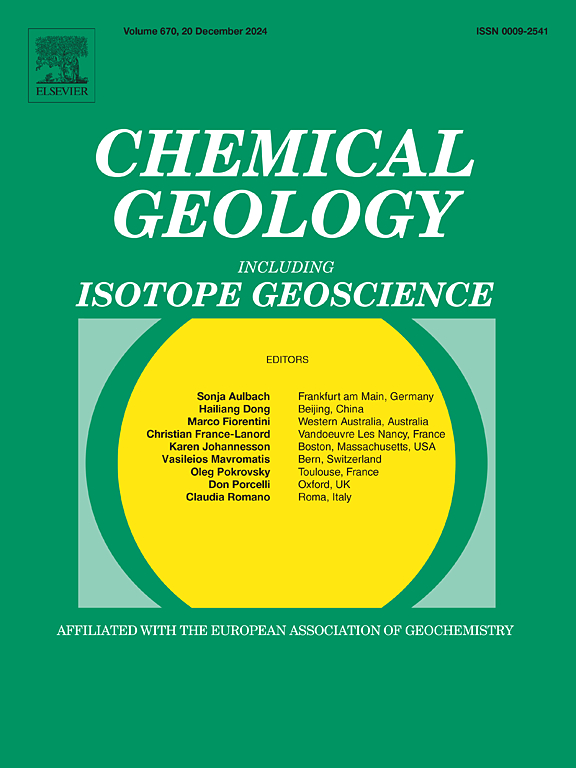苏必胜省Pikwitonei域北部地壳改造与古太古代变质作用:3.9 ~ 3.2 Ga碎屑锆石U-Pb-Hf-TE分析
IF 3.6
2区 地球科学
Q1 GEOCHEMISTRY & GEOPHYSICS
引用次数: 0
摘要
对加拿大西北苏必利尔省北部Pikwitonei麻粒岩域Armstrong组合中2个变质沉积岩的碎屑锆石进行了u- pb - lu - hf微量元素分析,探讨了原苏必利尔省古太古代地壳形成史和锆石成岩过程。每个样品的锆石年龄谱跨度为3.85 ~ 2.65 Ga,时间跨度为10亿年,以3.85 ~ 3.40 Ga的碎屑锆石年龄群为主。每个样品约3.85 Ga的碎屑锆石颗粒的亚球粒εHf(t)值在- 3.9 ~ - 1.0之间,与一套晚冥古宙至早太古代原岩的初始结晶一致。根据3.85 ~ 3.20 Ga碎屑锆石颗粒的单一统一Hf同位素演化趋势,推断出半连续的始古太古代地壳改造,与魁北克哈德逊湾东岸Nuvvuagittuq绿岩带的火成岩锆石种群相当。两个变质沉积岩样品的碎屑锆石颗粒微量元素分析表明,在3.67 Ga、3.5 Ga和3.4 Ga存在少量碎屑变质锆石,揭示了上古宙始古太古代可能发生的变质事件。此外,碎屑火成岩锆石颗粒的微量元素组成与含水烃源岩的部分熔融作用或长英质岩的岩浆改造/同化作用一致。微量元素组成与来自Acasta和Saglek地区约3.9-3.2 Ga火成岩锆石种群大致相似,同时表明了计算冥古宙-太古代锆石初始铀浓度的重要性。本文章由计算机程序翻译,如有差异,请以英文原文为准。
Crustal reworking and Eo-Paleoarchean metamorphism of the northern Pikwitonei domain, Superior Province: U-Pb-Hf-TE analysis of 3.9–3.2 Ga detrital zircon
U-Pb-Lu-Hf-trace element analysis of detrital zircon from two metasedimentary rocks of the Armstrong assemblage in the northern Pikwitonei granulite domain of the NW Superior Province (Manitoba, Canada) are used to explore the Eo-Paleoarchean crustal formation history and zircon petrogenetic processes of the proto-Superior craton. The zircon age spectrum from each sample spans a billion-year period from 3.85 to 2.65 Ga, with a predominant 3.85–3.40 Ga detrital zircon age population. The ca. 3.85 Ga detrital zircon grains from each sample have subchondritic εHf(t) values between −3.9 and − 1.0, consistent with initial crystallization from a suite of late-Hadean to early-Eoarchean protoliths. Semi-continuous Eo-Paleoarchean crustal reworking is subsequently inferred based on the single uniform Hf isotope evolution trend for 3.85–3.20 Ga detrital zircon grains, which is comparable to igneous zircon populations from the Nuvvuagittuq greenstone belt on the eastern shore of Hudson Bay in Quebec. Trace element analysis of detrital zircon grains from both metasedimentary samples indicate the limited presence of detrital metamorphic zircon at 3.67 Ga, 3.5 Ga and 3.4 Ga, which reveal potential metamorphic events within the Eo-Paleoarchean Superior Province. In addition, the detrital igneous zircon grains have trace element compositions consistent with either partial melting of hydrous source rocks or magmatic reworking/assimilation of felsic rocks. The trace element compositions are broadly similar to ca. 3.9–3.2 Ga igneous zircon populations from Acasta and Saglek regions, while demonstrating the importance of calculating initial U concentrations for Hadean – Archean zircon.
求助全文
通过发布文献求助,成功后即可免费获取论文全文。
去求助
来源期刊

Chemical Geology
地学-地球化学与地球物理
CiteScore
7.20
自引率
10.30%
发文量
374
审稿时长
3.6 months
期刊介绍:
Chemical Geology is an international journal that publishes original research papers on isotopic and elemental geochemistry, geochronology and cosmochemistry.
The Journal focuses on chemical processes in igneous, metamorphic, and sedimentary petrology, low- and high-temperature aqueous solutions, biogeochemistry, the environment and cosmochemistry.
Papers that are field, experimentally, or computationally based are appropriate if they are of broad international interest. The Journal generally does not publish papers that are primarily of regional or local interest, or which are primarily focused on remediation and applied geochemistry.
The Journal also welcomes innovative papers dealing with significant analytical advances that are of wide interest in the community and extend significantly beyond the scope of what would be included in the methods section of a standard research paper.
 求助内容:
求助内容: 应助结果提醒方式:
应助结果提醒方式:


